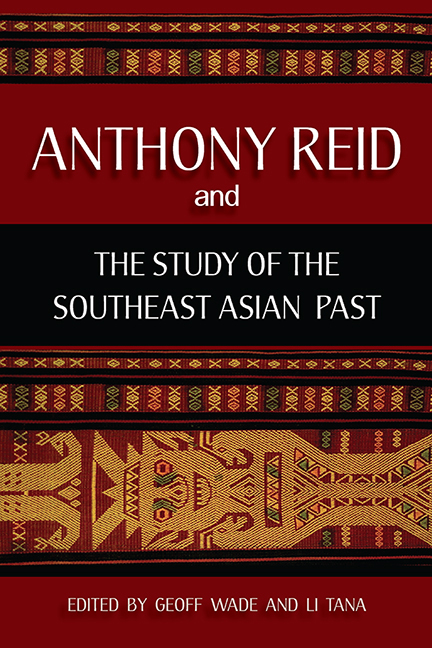Book contents
- Frontmatter
- Contents
- Acknowledgements
- The Contributors
- PART I Introduction
- PART II The Scholarship of Anthony Reid
- PART III Southeast Asia in the World
- PART IV Early Modern Southeast Asia
- PART V Modern Southeast Asia
- 13 Hadhrami Projections of Southeast Asian Identity
- 14 Absent at the Creation: Islamism's Belated, Troubled Engagement with Early Indonesian Nationalism
- 15 Chinese Shrines Contested: Power and Politics in Chinese Communities in Bangkok in the Early Twentieth Century
- Appendix
- Index
- Plate section
15 - Chinese Shrines Contested: Power and Politics in Chinese Communities in Bangkok in the Early Twentieth Century
from PART V - Modern Southeast Asia
Published online by Cambridge University Press: 21 October 2015
- Frontmatter
- Contents
- Acknowledgements
- The Contributors
- PART I Introduction
- PART II The Scholarship of Anthony Reid
- PART III Southeast Asia in the World
- PART IV Early Modern Southeast Asia
- PART V Modern Southeast Asia
- 13 Hadhrami Projections of Southeast Asian Identity
- 14 Absent at the Creation: Islamism's Belated, Troubled Engagement with Early Indonesian Nationalism
- 15 Chinese Shrines Contested: Power and Politics in Chinese Communities in Bangkok in the Early Twentieth Century
- Appendix
- Index
- Plate section
Summary
INTRODUCTION
Today, more than 650 Chinese shrines are officially registered with the Ministry of Interior, Thailand. The legal grounds for this registration system is the Ministerial Regulations on Chinese Shrines (sanchao) enacted on 15 March 1921. The regulations, jointly issued under the names of the Minister of Local Government and the Minister of Interior, laid the legal groundwork for the government control and “protection” of these religious institutions, by obliging all the Chinese shrines situated on government land or on donated land to have their title deeds made out in the names of the local authorities and their names entered into the list of registered shrines.
Seen from a present-day perspective, the regulations appear to have been favourably received in Thailand. The Ministry of Interior, for instance, recently launched a project to select excellent shrines of the year from among the registered shrines and grant them a pair of royal photos of the king and the queen. However, if we look back in history, the Chinese in Bangkok strongly opposed these regulations at their promulgation. The Siamese government legitimized the introduction of the regulations by explaining that their purpose was to prevent the use of the premises occupied by shrines for illegal purposes such as gambling and meetings of secret societies and to prevent misuse of shrine funds by certain individuals so that the benefits of the great majority of law-abiding Chinese could be protected. Despite this, the regulations evoked strong objections from the Chinese communities in Bangkok.
Based on unpublished Thai archival materials, this essay examines the background and ramification of the regulations. In doing so, it reveals the politics and political strategies of the Chinese in Bangkok and the role of shrines in their communities, which extended beyond religious activities, in the early twentieth century.
THE MINISTERIAL REGULATIONS ON CHINESE SHRINES OF 1921
On 6 August 1920, Chaophraya Yommarat, the Minister of Local Government (Krasuang Nakhonban) in charge of the administration of Bangkok, submitted a draft of the Ministerial Regulations on Chinese Shrines to King Wachirawut and asked for his royal endorsement.
- Type
- Chapter
- Information
- Anthony Reid and the Study of the Southeast Asian Past , pp. 336 - 356Publisher: ISEAS–Yusof Ishak InstitutePrint publication year: 2012



